History
A Moment of Silence
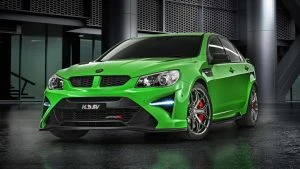
Holden HSV
Over the last decade there have been a few car manufacturers who have pulled out of selling cars in Australia. But, as those leave, there have also been numerous new marques who have arrived on the scene, which is great to see. Let’s not forget the old faithful marques, who are the manufacturers like Toyota, Honda, BMW and Porsche who have been selling cars in Australia for three decades or more. So what’s changed over the last ten years?
Over this last decade we have had to say goodbye to Holden – perhaps the saddest exit. The company was founded in 1856 as a saddlery manufacturer in South Australia, only to be wound up over the last year or so. The Holden roots in Australia have run very deep.
Chery made its arrival in 2011 and stuck around for a few beers and was off again in 2016. Chery once sold Australia’s cheapest new car for under $10k.
During the last decade, Dodge wrapped things up as well, though we still see the RAM logo in the form of the RAM Trucks that are sold new in Australia. A RAM Truck is the king of the Ute/light truck world.
Equally as sad, for some, as the vanishing of Holden has been the cessation of the awesome line of HSV (Holden Special Vehicles) and FPV (Ford Performance Vehicles) muscle cars. Oh how things change when people get a whiff of the climate change spin and big money opportunities with such amazing “clean” vehicles like EVs.
One luxury marque that made a brief appearance was Infiniti. Only recently, we’ve waved goodbye to this very classy and elegant line of cars that for some reason struggled to make their way into a buyer population who were stayed in their buying habits. Some of the Infiniti cars were seriously quick, had unique style and were reliable and comfortable.
2012 saw Opel opening many showrooms across Australia. The new Opel Astra and Opel Insignia cars were quite stylish cars, though they only managed a few sales. They too had a few beers and then folded up a year or two later.
Proton cars also came onto the scene in 2012 and sold a few hundred cars, however the aging models did not sell well in 2017 at all, so they were axed. There are rumours of them making a comeback with a new range of cars under Geely’s ownership.
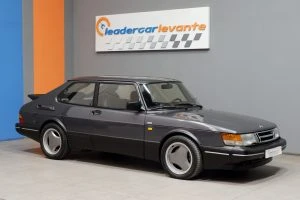
1991 Saab 900 Turbo 16 S
Another very sad day in the last decade of the Australian and global motoring industry was when Saab were forced to wrap up. I miss their individuality and the range of powerful four-cylinder, turbocharged engines. Australia has also said goodbye to Smart cars, a range of tiny city cars that were made by Mercedes. They never sold well.
The new popular car marques that have entered the Australian car market over the last few years has been: Genesis, Great Wall, Haaval, LDV, Mahindra, MG, RAM Trucks and Tesla. Most of these are of Asian origin.
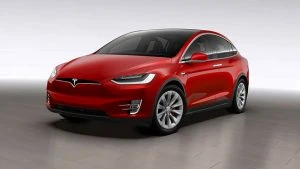
Tesla
Aussie’s Rosco aiming for 1000 mph
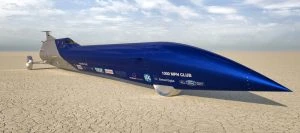
Aussie Invader 5R
It might be a bit hard to call it a conventional car but then it’s not really a conventional car in the sense that the Aussie Invader 5R rocket-car looks more plane/rocket in its appearance. The Aussie Invader 5R rocket-car boasts an insanely long arrow-shaped design with three wheels, large aerodynamic wind deflectors and an engine with close to 150,000 kW! Yes, that’s correct; you did read that figure correctly. To put that in perspective, an Aussie V8 Supercar puts out, on average, around 475 kW of power. Now, if you’ve ever experienced the wonderful roar of these V8s when they blast by around the circuit, then you can understand the aura of such kW potency. But this Aussie Invader 5R rocket-car makes as much power as 316 of these Aussie V8 Supercars put together! The Aussie Invader 5R rocket-car is powered by a single bi-propellant rocket reportedly capable of producing upwards of 62,000 lbf of thrust. That’s over four times more than a Boeing 737 jet!
Founder and designer of the new Aussie Invader 5R rocket-car, Rosco McGlashan, has the world’s fastest land speed record in his sights. He will reportedly be the pilot of the 16-metre long, nine-tonne steel-framed vehicle. And the target? The target top speed of 1609 km/h (1000 mph) would be the fastest of any land-going vehicle, ever. And 1000 mph would see it blitz the current land speed record held by the Noble Thrust SSC on a Nevada salt flat in 1997, which averaged 1223.7 km/h and broke the sound barrier while doing so.
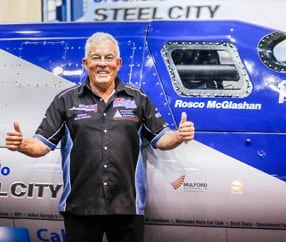
Rosco McGlashan
Rosco McGlashan would like to set the new record next year once all the Covid palaver is over-and-done-with, and it will likely be set somewhere in the Queensland or Western Australian desert. Rosco is no stranger to setting speed records; he is already the holder of the Australian land speed record, where in 1994 he clocked 802.6 km/h behind the wheel of a jet-powered predecessor to the Aussie Invader 5R out on the dry salt flats of Lake Gairdner, near Adelaide. He has, after all, built all of his drag racing, exhibition, and land-speed racing vehicles himself over the years in a shed at his home.
Rosco has accurate computer modelling on the Aussie Invader 5R rocket-car, which suggests that the Aussie Invader 5R rocket-car will have enough power and thrust for launching the car from 0-100 km/h in approximately 1.1 seconds. It should reach its target of 1000 mph in less than 30 seconds. Slowing the Aussie Invader 5R rocket-car down is no mean feat and will thus will require a full 13 km of flat desert just to stop it. A multi-stage deployment of high-speed hydraulic air brakes, mid-speed parachutes, and low-speed disc brakes have been designed to activate progressively to safely bring the vehicle to a halt.
Picking an exact location will depend largely on which organization or individual steps up as the primary sponsor for the effort. As will the practical necessity of having 5 km of flat desert for getting up to speed plus another 13 km to stop it.
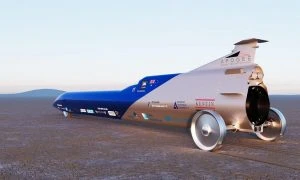
Aussie Invader 5R
Electric History: Hispano-Suiza Carmen Boulogne.
One of the oldest names in automotive and aviation circles, Hispano-Suiza, has launched a second vehicle in its 21st century rebirth. In 2019 the company unveiled the Carmen, a re-interpretation of a classic design from the 1930s called the Dubonnet Xenia. The Carmen Boulogne is a sportier evolution of that iconic vehicle. It is a fully electric vehicle and exclusivity will be stratospheric. Just five will be produced.
Dubonnet Xenia 1930s
The company’s lineage can be traced back over 120 years. Emilio de la Cuadra, a Spanish artillery captain, had been working on electric cars in Barcelona in 1898. During a visit to Paris, he met and subsequently employed Marc Birkigt, a Swiss born engineer. The pair collaborated and swiftly produced two gasoline powered engines which were released in 1900. Some financial hiccups saw a restructuring in 1902 and 1903, with a new owner and name change to Fábrica Hispano-Suiza de Automóviles (Spanish-Swiss Automobile Factory) which went bankrupt in 1903.
La-Cuadra automobile
José María Castro Fernández was the owner and in 1904 the company underwent yet another rebuild, this time more successfully and known as La Hispano-Suiza Fábrica de Automóviles. Damian Mateu, a Spanish entrepreneur, would partner with Birkigt to formalise the rebirth, and his granddaughter, Carmen, is the inspiration for the naming of the company’s 21st century vehicles. Come WW1 and aircraft engines would be produced under the watchful eyes of Birkigt. 1919 and they returned to automotive manufacturing and grew from there.
The Boulogne name dates back to 1921, when Hispano Suiza made a racing version of its high-performance H6 Coupé and entered it in the George Boillot Cup, an endurance race lasting more than 3.5 hours around the French city of Boulogne. Three consecutive victories with André Dubonnet (1921), Paul Bablot (1922), and Léonce Garnier (1923) driving the mighty Hispano Suiza H6, would be the results.
The Hispano Suiza Carmen Boulogne pays tribute to these historic motorsport victories with this fully electrically powered version packing 1,100hp/820 kW and a maximum velocity of 180mph/290kmh. The sprint to 100kmh (62mph) will take just 2.6 seconds. Four permanent-magnet synchronous engines, two on each rear wheel, will power the carbon fiber roof, body, and subframed Carmen Boulogne. The design, engineering, and production of the Carmen Boulogne is a result of a collaboration between Hispano-Suiza and a company specializing in the development of electric motors and motorsports, QEV Technologies.
Formula-E, a race series and a working test-bed for battery powered vehicles, has contributed to the development of the 1,180ft-lb/1,600Nm engines, and lithium-ion polymer batteries. These have a capacity of 80kWh (and can be upgraded later, says the company, with a 105kWh pack in development), and can see the Carmen Boulogne to a range of up to 250 miles/400 kilometres.
2021 Hispano-Suiza Carmen Boulogne
They are an in-house designed and produced T-shaped unit, including a complete temperature control system (including three radiators) to ensure that the cells can operate optimally. It has a fast-charging capacity of more than 80 kW DC, requiring only 30 minutes to charge to 30-80% capacity via a CCS2 fast charger. It also has CHAdeMO and GB/T charging options. Torque-vectoring is employed to ensure the Carmen Boulogne is kept straight under acceleration.
That 4.7 meter long carbon fiber body will be protected by coats of clear varnish, allowing those outside to see the strength of the material, and the emphasis on light-weight sportiness. It will also dramatically emphasise the slippery design, with a drag co-efficient of just 0.32cD. The distinctive semi-circular headlights of the Carmen will be kept, and flanked by a new copper coloured grille, with highlights of the same hue found inside.
2021 Hispano-Suiza Carmen Boulogne cabin
The five buyers can customise the Carmen Boulogne to their own bespoke tastes, thanks to Hispano-Suiza’s “Unique Tailormade” in-house department. Suede or Alcantara will be the interior trim choices as a starting point.
Pricing for the Hispano-Suiza Carmen Boulogne starts from 1.65 million euros plus local taxes (approx USD1,942,000), and its manufacturing process, handmade with the utmost precision, requires approximately twelve months.
The five units of the Carmen Boulogne hypercar join the 14 units of the Carmen to reach a total of 19 units in production, with the first unit ready to be delivered in 2022.
2021 Hispano-Suiza Carmen Boulogne tail
Holden History To Go On Tour.
With Holden soon to be all but a part of history as a brand, one final roll of the dice sees a tour of some of the company’s heritage collection vehicles to visit car museums around Australia. 
The Managing Director for GM Australia and New Zealand, Marc Ebolo, said over 80 vehicles and 30 engines will be available: “There has been considerable speculation with regards to what was going to happen to these iconic pieces of automotive heritage, and I’m pleased to reveal we are displaying our vehicle collection in Australia. We have never thought about sending it overseas. The vehicles which make up this multi-million dollar collection have been loaned to a variety of museums and will go on display in the very near future. This will be the first time the entire collection of Holden production and concept vehicles has been released simultaneously for public viewing.”
The last half-decade has seen a select group of Holden enthusiasts made up of largely retired souls in Victoria and South Australia cataloguing the collection, working to preserve the historic aspect of the cars and mechanicals, memorabilia, plus print and photo materiel. Some of the items are close to one hundred years old and have been treated with courtesy and respect in order to help tell the story of Holden. The display will start with the saddlery origins in the late 1800s, through to the 48-215 and beyond. “GM is sincerely grateful for the work our Holden Heritage Group of retiree volunteers has done to sort, digitise and safely store many thousands of items relating to Holden’s rich manufacturing and iconic brand history.” said Mr Ebolo. “We are planning to launch a Holden Heritage Collection website next year which will provide enthusiasts with information about the collection, as well as details of where to view the vehicles.”
The display will start with the saddlery origins in the late 1800s, through to the 48-215 and beyond. “GM is sincerely grateful for the work our Holden Heritage Group of retiree volunteers has done to sort, digitise and safely store many thousands of items relating to Holden’s rich manufacturing and iconic brand history.” said Mr Ebolo. “We are planning to launch a Holden Heritage Collection website next year which will provide enthusiasts with information about the collection, as well as details of where to view the vehicles.” 
Assistance was sought from the National Museum of Australia, interested groups and museums, plus the Commonwealth Office for the Arts and the History Trust of South Australia, and Museums Victoria. The idea was to map out a plan best suited to the preservation of the items and how to make it as accessible as possible to visitors and enthusiasts.
The current schedule has the History Trust of SA’s National Motor Museum in Birdwood, South Australia, the state in which Holden began as a saddlery in 1859, as the first location to make the display available. A short list of some of the vehicles includes the Holden Number 1 as unveiled by the then Prime Minister Ben Chifley in 1948, along with the beautiful concept car, “Hurricane” in 1969, and the one millionth Holden, an EJ.
The planning process was comprehensive, with an Advisory Committee formed specifically for the project. The chairman is the Director of the National Museum, Dr Mathew Trinca AM, and the committee was formally announced by the Federal Minister for the Arts, the Hon. Paul Fletcher MP.
“We more than anybody recognise how important this collection is to Australia and particularly to the people who have worked at Holden and owned Holden cars. We greatly appreciate Minister Fletcher’s interest in the Holden collection and the work and valuable advice of Dr Mathew Trinca, the National, Victorian and South Australian museums and interest groups and the Commonwealth Office for the Arts, on how to best preserve our heritage collection in Australia. We hope that with the opening of state borders and as Australians go on holidays, they will visit the various museums where these wonderful Holden cars will be displayed.” said Mr Ebolo.